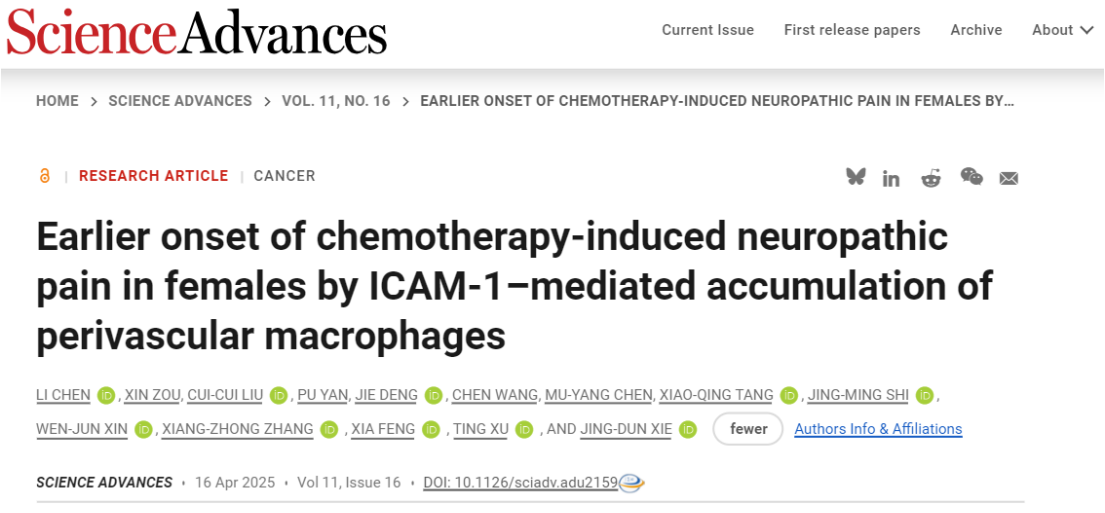Science Advances|Professor Xin Wenjun and Associate Professor Xu Ting's team made new progress in the study of the gender difference mechanism of neuropathic pain induced by chemotherapy
The role of gender in the occurrence and development of various diseases has been a growing area of focus in recent years. When it comes to pain, epidemiological studies show that women are more likely to experience chronic pain throughout their lives and to develop persistent pain conditions. They also exhibit lower pain thresholds, higher subjective pain scores, and longer pain duration, a phenomenon that has garnered clinical attention. However, basic research has long paid insufficient attention to these differences. Particularly in the establishment of animal models and mechanistic studies, male models have been widely used, while female individuals are often excluded. This research bias has limited our comprehensive understanding of the biology of pain in women and, to some extent, hindered the development of individualized and precise clinical treatment strategies. Therefore, in-depth exploration of the role of gender in the mechanisms of pain occurrence and development is of great significance for improving the pain research system and optimizing clinical intervention targets.
On April 16, 2025, a collaborative team led by Professor Xin Wenjun and Associate Professor Xu Ting from the Zhongshan School of Medicine, Sun Yat-sen University, along with Professor Xie Jingdun from the Sun Yat-sen University Cancer Center, Professor Feng Xia from the First Affiliated Hospital of Sun Yat-sen University, and Professor Zhang Xiangzhong from the Third Affiliated Hospital of Sun Yat-sen University, published a research paper entitled "Earlier onset of chemotherapy-induced neuropathic pain in females by ICAM-1–mediated accumulation of perivascular macrophages" in the journal Science Advances. Focusing on chemotherapy-induced neuropathic pain (CINP) and using bortezomib (BTZ) as an example, the study revealed the gender differences in BTZ-induced neuropathic pain and proposed a theoretical framework where the ICAM-1-mediated gender-specific immune pathway drives the activation of the "perivascular macrophage–astrocyte–neuron" signaling axis, thereby triggering BTZ-related neuropathic pain in females.

The research team first conducted a clinical retrospective analysis and found that female patients with multiple myeloma developed sensory disturbances earlier during BTZ treatment, and this phenomenon was not affected by age, disease type, or stage, suggesting the existence of a gender-specific pain-causing mechanism. In the C57 mouse model, it was confirmed that ICAM-1 mediates spinal macrophage infiltration in female mice, promotes the release of CCL1, which then acts on neurons and astrocytes, thereby enhancing spinal neuron excitability and inducing early mechanical hyperalgesia. This study systematically revealed the molecular mechanism underlying the early onset of bortezomib-induced neuropathic pain in female individuals through both clinical and animal model research. Elucidating this mechanism not only deepens our understanding of gender differences in chemotherapy-related pain but also provides potential drug targets and theoretical basis for precise analgesic treatment in female patients with multiple myeloma.
Chen Li, a doctoral student of our university, Zou Xin, a master's student, Liu Cuicui from Sun Yat-sen University Sun Yat-sen Memorial Hospital, and Yan Pu from The Chinese University of Hong Kong (Shenzhen) Affiliated Second Hospital/Shenzhen Longgang District People's Hospital are the co-first authors of the paper. The research was supported by the National Natural Science Foundation of China, key projects of Guangdong Province, and Guangzhou Science and Technology Program, among others.
Original article link: https://www.science.org/doi/10.1126/sciadv.adu2159


